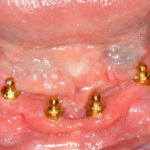
Total tooth loss or edentulism is considered to be a disability by the WHO and is accompanied by a reduction in quality of life. It is affected by a range of factor included by access to care and socio-economic status and varies both within and between countries. Edentulism is treated by prosthodontic restoration using implant or tissue supported approaches.
The aim of this Cochrane review was to compare different attachment systems for maxillary and mandibular implant overdentures by assessing prosthodontic success, prosthodontic maintenance, patient preference, patient satisfaction/quality of life and costs.
Methods
Searches were conducted in the Cochrane Oral Health’s Trials Register, the Cochrane Central Register of Controlled Trials (CENTRAL), Medline, Embase, the US National Institutes of Health Ongoing Trials Register (ClinicalTrials.gov) and the World Health Organization International Clinical Trials Registry Platform with no restrictions on the language or date of publication. Randomised controlled trials (RCTs), including cross-over trials on maxillary or mandibular implant overdentures with different attachment systems with at least 1-year follow-up were considered.
Four reviewers independently extracted data and assessed rick of bias. Fixed effects meta-analysis was used to combine data, continuous outcomes were reported as mean differences (MD) with 95% confidence intervals (CI) and dichotomous outcomes as odds ratios (OR) with 95%CI. The GRADE approach was used to assess the overall body of evidence for the main outcomes.
Results
- 6 RCTs involving a total of 294 mandibular overdentures were included.
- All 6 trials were considered to be at high risk of bias.
- No trials on maxillary overdentures were eligible.
- Poor outcome reporting in included trials limited the analysis
Ball and bar attachments
- No data pooling was conducted for prosthodontic success.
- Short-term re-treatment (repair of attachment system) was higher with ball attachments; RR =3.11(95%CI; 1.68 to 5.75) 130 participants; 2 studies; very low-quality evidence.
- No difference between both attachment systems in short-term re-treatment (replacement of attachment system). RR = 1.18(95%CI; 0.38 to 3.71) 130 participants; 2 studies; very low-quality evidence.
- It is uncertain if there is a difference in short-term prosthodontic success when ball attachments are compared with bar attachments.
Ball and magnet attachments
- No difference between them in medium-term prosthodontic success. RR = 0.84 (95%CI; 0.64 to 1.10) 69 participants; 1 study; very low-quality evidence), or in
- medium-term re-treatment (repair of attachment system. RR =1.75(95%CI; 0.65 to 4.72) 69 participants; 1 study; very low-quality evidence)
- However, after 5 years, prosthodontic maintenance costs were higher when magnet attachments were used (MD= -247.37 EUR (95%CI; -346.32 to -148.42) 69 participants; 1 study; very low-quality evidence.
- It is uncertain whether there is a difference in medium-term prosthodontic success when ball attachments are compared with magnet attachments.
Ball versus telescopic attachments
- A single trial (22 participants; 1 study; very low-quality evidence)
- reported no difference in prosthodontic maintenance between the two systems in short-term patrix replacement. RR= 6.00 (95%CI; 0.86 to 41.960
- matrix activation; RR = 11.00(95%CI; 0.68 to 177.72)
- matrix replacement; RR= 1.75 (95%CI; 0.71 to 4.31)
- relining of the implant overdenture; RR= 2.33 (95%CI; 0.81 to 6.76)
- It is uncertain whether there is a difference in short-term prosthodontic maintenance when ball attachments are compared with telescopic attachments.
In the only cross-over trial included, patient preference between different attachment systems was assessed after only 3 months and not for the entire trial period of 10 years.
Conclusions
The authors concluded:-
For mandibular overdentures, there is insufficient evidence to determine the relative effectiveness of different attachment systems on prosthodontic success, prosthodontic maintenance, patient satisfaction, patient preference or costs. In the short term, there is some evidence that is insufficient to show a difference and where there was no evidence was reported. It was not possible to determine any preferred attachment system for mandibular overdentures.
For maxillary overdentures, there is no evidence (with no trials identified) to determine the relative effectiveness of different attachment systems on prosthodontic success, prosthodontic maintenance, patient satisfaction, patient preference or costs.
Further RCTs on edentulous cohorts must pay attention to trial design specifically using the same number of implants of the same implant system, but with different attachment systems clearly identified in control and test groups. Trials should also determine the longevity of different attachment systems and patient preferences. Trials on the current array of computer-aided designed/computer- assisted manufactured (CAD/CAM) bar attachment systems are encouraged.
Comments
This well conducted review highlights that there is insufficient evidence for determine the relative effectiveness of different types of overdenture attachment systems. The review also found no RCTs assessing the effectiveness of maxillary overdentures. While we have blogged about a number of other reviews on overdentures (Dental Elf – Overdenture blogs) many of those include studies other than RCTs often including studies of short duration. As the authors indicated there is a clear need for high-quality well conducted trials in this area for while dental health has improved in many countries there are still significant numbers of patients who are edentate and will increasing life expectancy are likely to require effective treatments for longer.
Links
Primary Paper
Payne AGT, Alsabeeha NHM, Atieh MA, Esposito M, Ma S, Anas El-Wegoud M. Interventions for replacing missing teeth: attachment systems for implant overdentures in edentulous jaws. Cochrane Database of Systematic Reviews 2018, Issue 10. Art. No.: CD008001. DOI: 10.1002/14651858.CD008001.pub2.
Other references
Dental Elf – Overdenture blogs
Picture Credits
By Coronation Dental Specialty Group[1] – Own work, CC BY-SA 3.0
